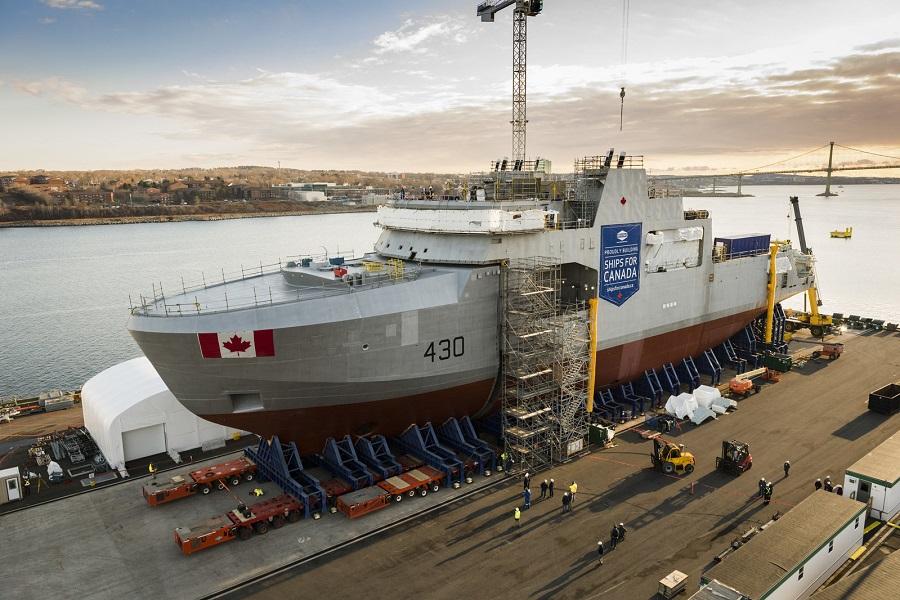In December Fincantieri of Italy and Naval Group of France decided not to bid on the Canadian Surface Combatant project. Instead, they offered the Canadian government a direct proposal that would see the the companies build 15 of the consortium’s FREMM frigates at a fixed price of roughly $30 billion.
The Liberal government rejected the offer.
| A FREMM frigate sails off the coast of France in 2016. BORIS HORVAT/AFP/GETTY IMAGES |
Fincantieri and Naval Group knew they were taking a chance when they passed on the formal bidding process for the CSC. Sources close to the European companies said at the time they felt they didn’t have anything to lose. They alleged the Canadian competition was skewed to favour a bid by Lockheed Martin Canada and the British firm BAE which would see Canada buying the Type 26 frigate BAE is building for Britain’s navy.
The Canadian government had originally asked for only bids featuring proven ship designs. But it later changed those parameters to allow a bid from BAE, though the Type 26 was at the time still on the drawing board.
Giuseppe Bono, the CEO of Fincantieri, recently told my colleagues at the U.S. publication Defense News of another concern that led to the decision not to bid on the CSC. Bono said that the firms were willing to turn over their sensitive technical data to the Canadian government but that they drew the line at providing the proprietary information to Irving and its team.
“We said we were prepared to give the information to the Canadian government but not to a rival company if we didn’t know if we were going to win the bid or not,” Bono said.
Fincantieri and Naval Group, along with other companies, have voiced concerns about Irving’s alliance with the U.S. firm, Gibbs and Cox, a top U.S. naval architecture firm that designs surface warships. Gibbs and Cox is also the main competitor for many companies – including Fincantieri and Naval Group – pursuing ship contracts around the world.
Irving, however, has rejected such concerns and has stated it is committed to protecting any sensitive data provided by companies bidding on CSC.
But Fincantieri and Naval Group weren’t buying that reassurance.
The firms still have their proposal ready in case the Canadian procurement falls apart and the federal government decides on a different course of action.
In February, the U.S. Navy named the FREMM design as one of five it could consider for its future frigate program and has provided Fincantieri $15 million to look at a design concept.
The Canadian government had originally asked for only bids featuring proven ship designs. But it later changed those parameters to allow a bid from BAE, though the Type 26 was at the time still on the drawing board.
Giuseppe Bono, the CEO of Fincantieri, recently told my colleagues at the U.S. publication Defense News of another concern that led to the decision not to bid on the CSC. Bono said that the firms were willing to turn over their sensitive technical data to the Canadian government but that they drew the line at providing the proprietary information to Irving and its team.
“We said we were prepared to give the information to the Canadian government but not to a rival company if we didn’t know if we were going to win the bid or not,” Bono said.
Fincantieri and Naval Group, along with other companies, have voiced concerns about Irving’s alliance with the U.S. firm, Gibbs and Cox, a top U.S. naval architecture firm that designs surface warships. Gibbs and Cox is also the main competitor for many companies – including Fincantieri and Naval Group – pursuing ship contracts around the world.
Irving, however, has rejected such concerns and has stated it is committed to protecting any sensitive data provided by companies bidding on CSC.
But Fincantieri and Naval Group weren’t buying that reassurance.
The firms still have their proposal ready in case the Canadian procurement falls apart and the federal government decides on a different course of action.
In February, the U.S. Navy named the FREMM design as one of five it could consider for its future frigate program and has provided Fincantieri $15 million to look at a design concept.

